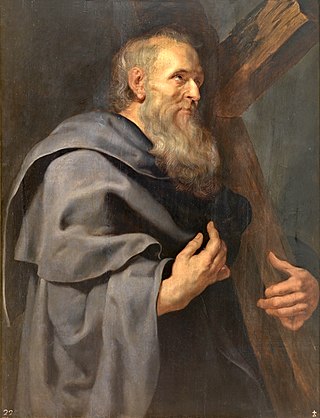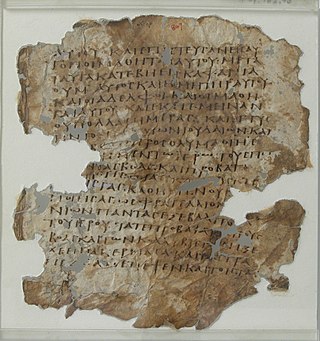
Nathanael [Note 1] , also known as Nathaniel [Note 2] of Cana was a disciple of Jesus, mentioned only in chapters 1 and 21 of the Gospel of John.
Contents
He is typically viewed as the same person as Bartholomew. [1]

Nathanael [Note 1] , also known as Nathaniel [Note 2] of Cana was a disciple of Jesus, mentioned only in chapters 1 and 21 of the Gospel of John.
He is typically viewed as the same person as Bartholomew. [1]
In the Gospel of John, Nathanael is introduced as a friend of Philip, from Bethsaida (1:43-44). [2] The first disciples who follow Jesus are portrayed as reaching out immediately to family or friends: thus, Philip found Nathanael and said to him, "We have found Him of whom Moses in the law, and also the prophets, wrote — Jesus of Nazareth, the son of Joseph". [3]
Nathanael is described as initially being skeptical about whether the Messiah could come from Nazareth, saying: "Can anything good come out of Nazareth?", [4] but nonetheless, he accepts Philip's invitation to find out. Jesus immediately characterizes him as "an Israelite in whom is no deceit". [5] Some scholars[ who? ] hold that when Jesus said, "Before Philip called you, when you were under the fig tree, I saw you", is based on a Jewish figure of speech, referring to studying the Torah.[ citation needed ] Nathanael recognizes Jesus as "the Son of God" and "the King of Israel". [6]
He reappears (as "Nathanael of Cana") at the end of John's Gospel, as one of the disciples to whom Jesus appeared at the Sea of Galilee after the Resurrection. [2] [7]
Nathanael is usually identified with Bartholomew the Apostle mentioned in the Synoptic Gospels and Acts 1:13. [2] [8] The reason for this identification is Bartholomew being a surname, and because Bartholomew and Philip are always paired together in the synoptic gospels. [9] The earliest known example of this identification is from Ishodad of Merv (c. 850). The earliest known reference in the West is in Rupert of Deutz (d. 1129).
However, some disagree with this identification. Augustine suspected that Nathanael was not one of the twelve at all because he was so versed in the law. [10] The earliest identification of Nathanael with one of the Twelve Disciples is found in the 2nd-century Epistula Apostolorum , where he is identified with or takes the place of James, son of Alphaeus. [11]

The Gospel of Matthew is the first book of the New Testament of the Bible and one of the three synoptic Gospels. It tells how Israel's Messiah, Jesus, comes to his people but is rejected by them and how, after his resurrection, he sends the disciples to the gentiles instead. Matthew wishes to emphasize that the Jewish tradition should not be lost in a church that was increasingly becoming gentile. The gospel reflects the struggles and conflicts between the evangelist's community and the other Jews, particularly with its sharp criticism of the scribes and Pharisees with the position that through their rejection of Christ, the Kingdom of God has been taken away from them and given instead to the church.

The Gospel of John is the fourth of the four canonical gospels. It contains a highly schematic account of the ministry of Jesus, with seven "signs" culminating in the raising of Lazarus and seven "I am" discourses culminating in Thomas' proclamation of the risen Jesus as "my Lord and my God". The gospel's concluding verses set out its purpose, "that you may believe that Jesus is the Christ, the Son of God, and that believing you may have life in his name."

Matthew the Apostle is named in the New Testament as one of the twelve apostles of Jesus. According to Christian traditions, he was also one of the four Evangelists as author of the Gospel of Matthew, and thus is also known as Matthew the Evangelist.

John the Apostle also known as Saint John the Beloved and in Eastern Orthodox Christianity, Saint John the Theologian was one of the Twelve Apostles of Jesus according to the New Testament. Generally listed as the youngest apostle, he was the son of Zebedee and Salome. His brother James was another of the Twelve Apostles. The Church Fathers identify him as John the Evangelist, John of Patmos, John the Elder, and the Beloved Disciple, and testify that he outlived the remaining apostles and was the only one to die of natural causes, although modern scholars are divided on the veracity of these claims.

Philip the Apostle was one of the Twelve Apostles of Jesus according to the New Testament. Later Christian traditions describe Philip as the apostle who preached in Greece, Syria, and Asia-Minor.

James the Just, or a variation of James, brother of the Lord, was "a brother of Jesus", according to the New Testament. He was the first leader of the Jerusalem Church of the Apostolic Age. Traditionally, it is believed he was martyred in AD 62 or 69 by being stoned to death by the Pharisees on order of High Priest Ananus ben Ananus. James, Joses, Simon, and Judas are mentioned as the brothers or siblings of Jesus as well as two unnamed sisters.

Simon the Zealot or Simon the Canaanite or Simon the Canaanean was one of the most obscure among the apostles of Jesus. A few pseudepigraphical writings were connected to him, but Jerome does not include him in De viris illustribus written between 392 and 393 AD.

Cana of Galilee is the location of the Wedding at Cana, at which the miracle of turning water into wine took place in the Gospel of John.

The wedding at Cana is the name of the story in the Gospel of John at which the first miracle attributed to Jesus takes place.

Jesus, also referred to as Jesus Christ, Jesus of Nazareth, and many other names and titles, was a first-century Jewish preacher and religious leader. He is the central figure of Christianity, the world's largest religion. Most Christians believe Jesus to be the incarnation of God the Son and the awaited messiah, the Christ that is prophesied in the Hebrew Bible.

John 1 is the first chapter in the Gospel of John in the New Testament of the Holy Bible. The author of the book containing this chapter is John that composed this gospel.

John 2 is the second chapter of the Gospel of John in the New Testament of the Christian Bible. It contains the famous stories of the miracle of Jesus turning water into wine and Jesus expelling the money changers from the Temple. The author of the book containing this chapter is anonymous, but early Christian tradition uniformly affirmed that John composed this gospel.

Mark 3 is the third chapter of the Gospel of Mark in the New Testament of the Christian Bible. It relates a conflict over healing on the Sabbath, the commissioning of the Twelve Apostles, a conflict with the Jerusalem scribes and a meeting of Jesus with his own family.

The ministry of Jesus, in the canonical gospels, begins with his baptism near the River Jordan by John the Baptist, and ends in Jerusalem in Judea, following the Last Supper with his disciples. The Gospel of Luke states that Jesus was "about 30 years of age" at the start of his ministry. A chronology of Jesus typically sets the date of the start of his ministry at around AD 27–29 and the end in the range AD 30–36.

John 6 is the sixth chapter of the Gospel of John in the New Testament of the Christian Bible. It records Jesus' miracles of feeding the five thousand and walking on water, the Bread of Life Discourse, popular rejection of his teaching and Peter's confession of faith. The final verses anticipate Jesus' betrayal by Judas Iscariot.

Luke 6 is the sixth chapter of the Gospel of Luke in the New Testament of the Christian Bible, traditionally attributed to Luke the Evangelist, a companion of Paul the Apostle on his missionary journeys. Jesus' teaching about the Sabbath enrages the religious authorities and deepens their conflict. The selection of twelve apostles is recounted and this is followed by the "Sermon on the Plain", where key aspects of Jesus' teaching are presented.

The following outline is provided as an overview of and topical guide to Christianity:

The commissioning of the Twelve Apostles is an episode in the ministry of Jesus that appears in all three Synoptic Gospels: Matthew 10:1–4, Mark 3:13–19 and Luke 6:12–16. It relates the initial selection of the Twelve Apostles among the disciples of Jesus.

In Christian theology and ecclesiology, the apostles, particularly the Twelve Apostles, were the primary disciples of Jesus according to the New Testament. During the life and ministry of Jesus in the 1st century AD, the apostles were his closest followers and became the primary teachers of the gospel message of Jesus. There is also an Eastern Christian tradition derived from the Gospel of Luke of there having been as many as seventy apostles during the time of Jesus' ministry.

John 1:45 is the 45th verse in the first chapter of the Gospel of John in the New Testament of the Christian Bible.